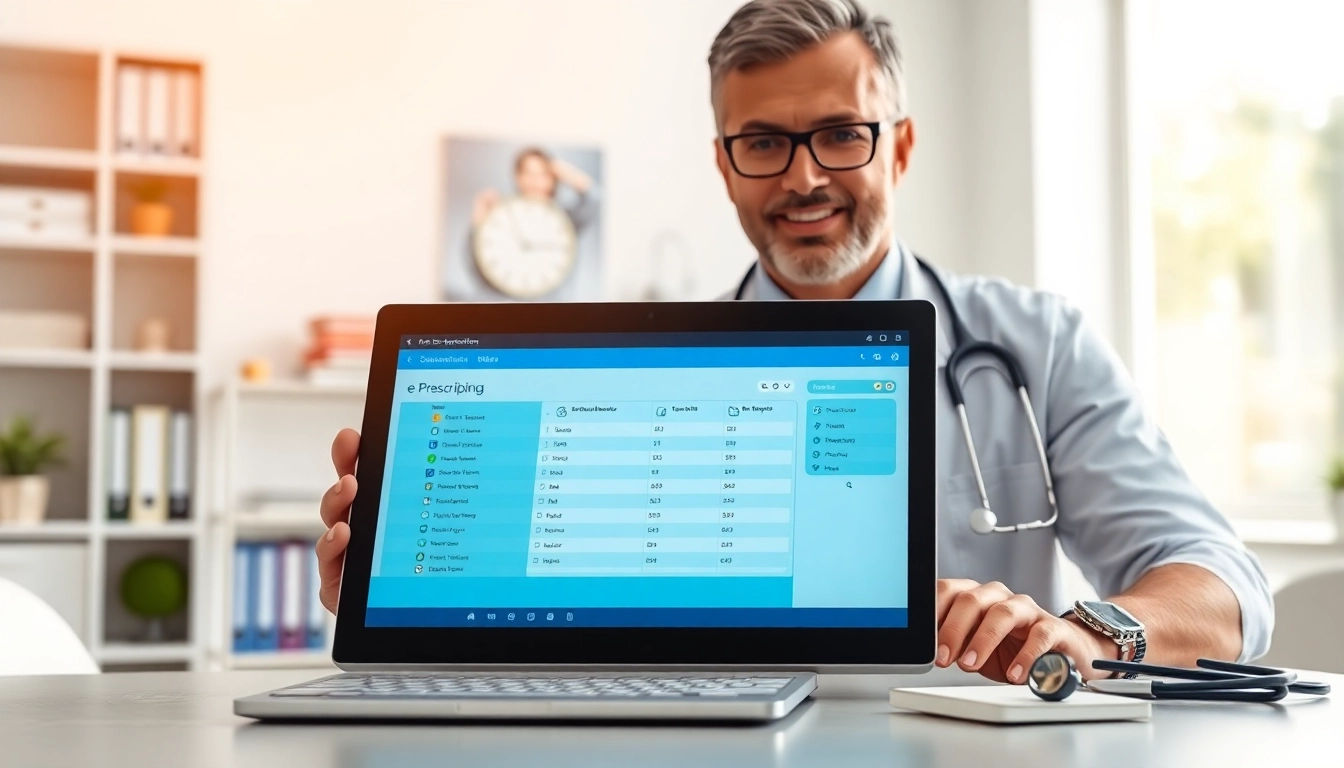Understanding Eprescription Apps for iOS
Definition and Purpose
Eprescription apps for iOS are mobile applications that facilitate the electronic prescribing of medications. By consolidating various functionalities, these apps enable healthcare providers such as doctors, nurse practitioners, and pharmacists to streamline the prescription process, enhancing overall efficiency in patient care. The primary purpose of these applications is to modernize the prescription workflow by enabling healthcare professionals to send prescriptions directly to pharmacies, ensuring accuracy, reducing medication errors, and improving patient outcomes.
Key Benefits of Eprescription Apps for iOS
The adoption of eprescription apps for ios comes with numerous benefits that can significantly impact clinical practice. Some of the key advantages include:
- Improved Accuracy: Digital prescriptions minimize handwritten errors, which are common in traditional methods.
- Efficiency: Providers can quickly generate and send prescriptions from anywhere, reducing wait times for patients.
- Enhanced Communication: Direct integration with pharmacies allows for real-time communication regarding prescriptions, dosage changes, or medication refills.
- Better Patient Safety: Built-in alerts for potential drug interactions and allergies help safeguard patient health.
- Record Keeping: Digital records of prescriptions provide a comprehensive history of patient medications, which is accessible at any time.
How Eprescription Apps for iOS Work
Eprescription apps typically function through a user-friendly interface that allows clinicians to select patient medications, adjust dosages, and provide special instructions. Additionally, most apps support user authentication and role permissions, ensuring that only authorized personnel can write prescriptions. Once a prescription is completed, it is transmitted electronically to the designated pharmacy, where it is processed without delay. Some apps integrate with Electronic Health Record (EHR) systems to link patient medication histories and allergies, enhancing the prescribing process through better data access.
Essential Features to Look for
User-Friendly Interface
A critical element of effective eprescription apps for iOS is a user-friendly design. The interface should be intuitive, allowing healthcare providers to easily navigate the app without extensive training. Key characteristics of a user-friendly interface include:
- Simplicity: Basic navigation menus that lead users to prescription functions with ease.
- Clarity: Clear labeling of icons and features that prevent misinterpretation.
- Responsiveness: Fast loading times and smooth transitions that enable efficient workflow.
Integration with Pharmacy Systems
Compatibility with various pharmacy systems is essential for seamless electronic prescribing. Effective eprescription apps should support direct API connections to local and national pharmacy networks, ensuring that prescriptions are received promptly. Enhanced integration capabilities might include:
- Real-Time Prescription Updates: Notifications for medication availability and prescription status.
- Customizable Pharmacy Lists: Easy access to preferred pharmacies tailored to a patient’s location.
- Electronic Prior Authorization: Streamlined processes for managing insurance approvals.
Security and Compliance Standards
Given the sensitive nature of patient health information, security is paramount when selecting eprescription apps. Healthcare providers must ensure that the app complies with regulatory standards such as HIPAA. Essential security features include:
- Data Encryption: Protecting patient data both in transit and at rest.
- User Authentication: Secure login processes, such as biometric authentication or two-factor authentication.
- Audit Trails: Comprehensive logs of user activity to monitor access and modifications.
Implementation Strategies for Healthcare Providers
Assessing Practice Needs
Before implementing eprescription apps for iOS, healthcare providers should thoroughly assess their specific needs and workflows. This may involve evaluating current prescribing processes, identifying pain points, and considering the specific types of medications that are commonly prescribed. Engaging staff in this evaluation can lead to essential insights that assist in selecting the best app for the practice. Additionally, understanding patient demographics can guide features that will be most beneficial, such as multilingual support or telehealth functionalities.
Training Staff Effectively
Even with user-friendly design, effective training is vital to ensure all staff can utilize the app fully. Comprehensive training sessions should cover basic functionalities, advanced features, data security practices, and protocols for troubleshooting common issues. Ongoing support, including access to help documentation and an FAQ section, encourages staff to adopt the new system confidently. Incorporating hands-on practice sessions allows staff to become familiar with the app in a real-world context.
Monitoring Usage and Feedback
Deploying the app within an organization requires continuous monitoring to ensure it meets operational goals. Collecting feedback from users can help identify potential issues, gauge satisfaction, and provide insights into how features are utilized. Setting Key Performance Indicators (KPIs) such as prescription turnaround time, user engagement, and error rates can benchmark success. Regularly assessing these metrics will also help guide modifications and enhance the system as needed.
Comparing Top Eprescription Apps for iOS
Feature Set Comparison
When evaluating various eprescription apps for iOS, it is crucial to compare their feature sets to determine which app aligns best with the healthcare provider’s objectives. Key features to consider include:
- Prescription Flexibility: The ability to manage both controlled and non-controlled substances.
- Mobile Compatibility: Functionality on various iOS devices, ensuring access regardless of device type.
- Refill Management: Tools for tracking and managing patient refills.
User Ratings and Reviews Analysis
User-generated reviews and ratings can provide valuable insights into the practical strengths and weaknesses of different eprescription apps. Analyzing feedback reveals common issues or praised features that are essential in real-world applications. It is advisable to focus on details regarding user experience, customer support responsiveness, and any software glitches or bugs caught by users.
Cost-Efficiency Overview
While many eprescription apps offer free trials, understanding the overall cost structure is vital in making an informed decision. Cost considerations should include:
- Subscription Models: Monthly or annual fees, and whether they offer scalable options for larger practices.
- Hidden Fees: Any additional costs that may arise from integrating with pharmacy networks or advanced feature sets.
- Return on Investment: Evaluating how the app’s features can enhance efficiency and patient safety relative to its cost.
Future Trends in Eprescription Technology
Advancements in Telehealth Integration
The rise of telehealth solutions continues to reshape how healthcare providers prescribe medications. Future eprescription apps are expected to integrate seamlessly with telehealth platforms, allowing for concurrent patient consultations and prescription management. This synergy not only enhances convenience for patients but also promotes comprehensive care by providing instant access to patient health records during virtual visits.
Potential for AI Assistants in Prescribing
Artificial Intelligence (AI) is set to revolutionize the landscape of e-prescriptions. Future applications are likely to leverage AI for predictive analytics, assisting providers in identifying potential patient risks based on historical data. Furthermore, AI-powered assistants may provide real-time recommendations regarding medication choices, dosages, and potential side effects, improving clinician efficiency and decision-making.
Enhancing Patient Engagement through Apps
As patients increasingly become involved in their healthcare decisions, future eprescription apps are anticipated to facilitate greater patient engagement. Features such as medication reminders, educational resources, and direct communication channels to healthcare providers can empower patients to take a more active role in managing their health. User-friendly interfaces that allow patients to access their medication history and refill requests will further enhance this engagement.



